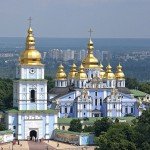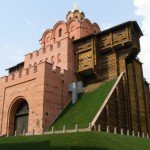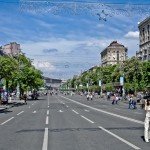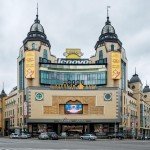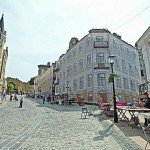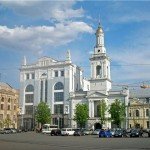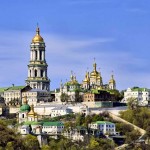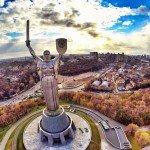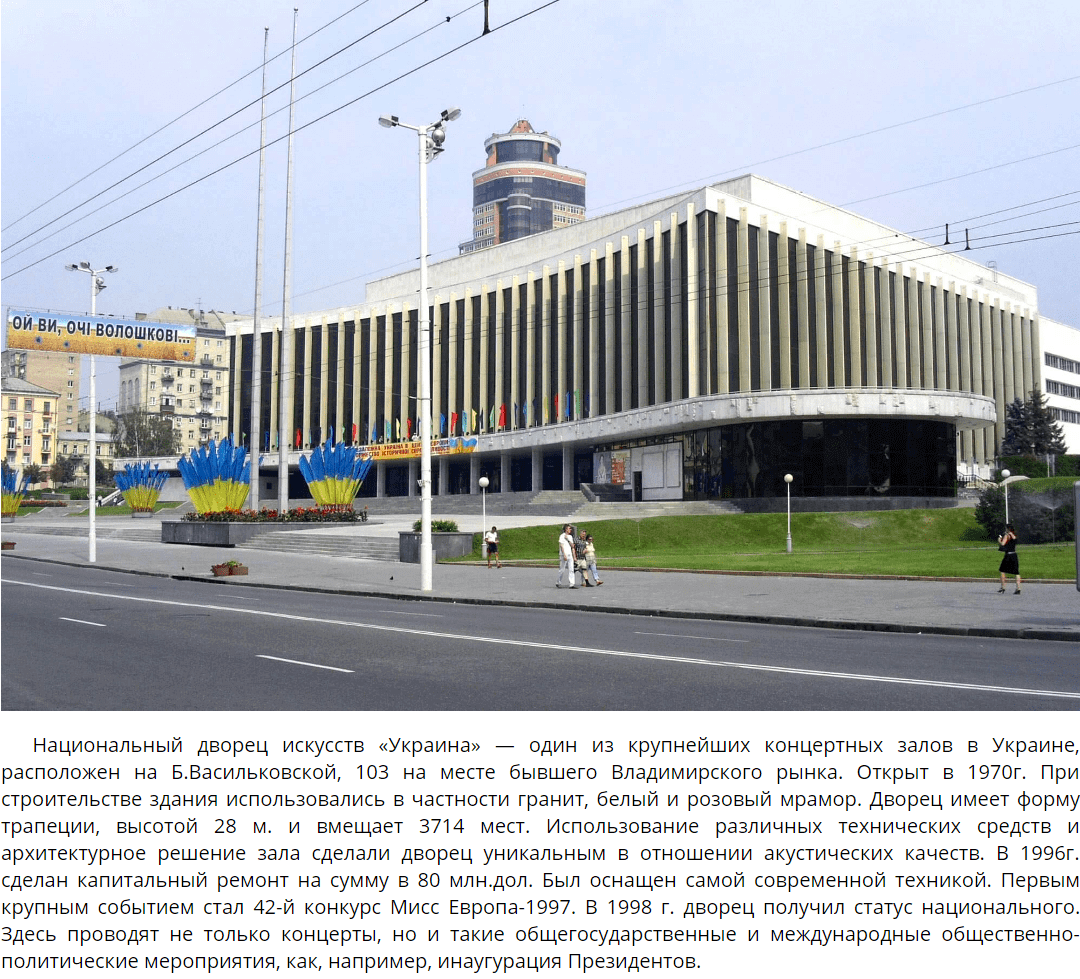Top 10 sights in Kiev
- 1. The St. Sophia Cathedral
- 2. St. Michael’s Golden-domed Cathedral
- 3. The Golden Gate
- 4. Khreshchatyk Street
- 5. “Arena City” mall
- 6. Andriivsky Descent
- 7. Podil
- 8. Kyiv-Pechersk Lavra
- 9. The Monument to Motherland
- 10. Mariinsky Park
1. The St. Sophia Cathedral – the greatest architectural structure, built by Yaroslav the Wise the Grand Prince in 1037. It preserved until now not only the richness of ancient architecture, but also the picturesque decoration of the 11th century, mainly mosaics and frescoes. Religious and state ideas of that time were embodied in the artistic image of Sophia of Kiev. The ensemble of mosaics is decorated with the main altar of the St. Sofia’s Temple.
Entering the Cathedral, the glance is captured by the majestic figure of the praying Virgin of Oranta (Divine Wisdom), located in the vault of the altar. Frescoes of St. Sophia Cathedral are an interesting source of information about the life of the prince’s court and that way of life. They are the only preserved collection of paintings from the period of Kievan Rus. There are graffiti, i.e. ancient Russian inscriptions, which are the most important document of the dating of murals, on the walls of the cathedral.
Apparently, the central part of the building works was performed in the 40’s, and in the galleries – in the 60s of the 11th century. Along with the famous ensembles of Ravenna, Venice, Montreal, Daphne, Palermo, ancient Constantinople, they occupy a prominent place in the treasury of world culture. St. Sophia Cathedral is included in the UNESCO’s World Heritage List.
2. St. Michael’s Golden-domed Cathedral – the oldest and greatest Orthodox shrine of Kyiv, founded by the grandson of Yaroslav the Wise, Svyatopolk Iziaslavovych the Prince on the territory of the Dmytriivskyi Monastery according to the chronicle in 1108 and it is dedicated to Michael the Archangel the heavenly patron. Originally, the temple was wooden, after several decades the church was rebuilt into a stone church. The name “Mykhailivsky” monastery was given likely, in honour of the patron saint of Kyiv – Archangel Michael. According to another version – the Mykhailivsky Monastery was founded by the first Kyiv Metropolitan Michael.
The name “Zlatoverkhyi” was granted due to the fact that it was the first cathedral with gilded domes made of solid gold leaf. After the Kyiv-Pechersk Lavra St. Michael’s Golden-domed Cathedral becomes the second place in Kyiv for pilgrimage. It contained the remains of several generations of Kyiv princes, which testifies to the significant role of the cathedral in the public life of the city and the state. St. Michael’s Cathedral is famous for its frescoes and mosaics, which the arts critics called a new trend in the evolution of painting of Ancient Rus.
The most famous shrine of the monastery was the relics of the St. Barbara the Great Martyr, delivered by the wife of Prince Svyatopolk, the daughter of the Byzantine emperor Alexis, who baptized Varvara. In 1240 the monastery was looted by the horde of Khan Baty. A new stage in the development of the Mykhailivsky Monastery became the XVII-XVIII centuries, the authority and influence of the monastery grew, at its disposal there were huge territories and villages (Borodyanka, Trypillya, Motovylivka, etc.).
At the end of the XVIII century the monastery of St. Michael’s Monastery was opened, which was called “Theophany”. In the XIX century on the territory of the monastery there was a real hotel complex, which served for the pilgrims. To the beginning of XX century there were a lot of parishioners, great services were held. After the Pechersk Lavra Mykhailivsky Monastery occupied the second place in Kyiv in terms of the number of parishioners and pilgrims. In 1937 the Cathedral was blown up. Valuable mosaics and frescoes were transferred to Sofia Kyiv, but some masterpieces (the mosaic “Dmytro Solunsky”, the fresco “Saint Nicholas”, the upper part of the fresco figure Samuel, etc.) were taken outside of Kyiv. In 2000 the monastery was restored.
3. The Golden Gate – the only gate that has survived since the times of Kyivan Rus. The Golden Gate appeared during the time of Prince Yaroslav the Wise and is mentioned in the annals of 1037. This is oldest defensive structure of Kyivan Rus served as the main gate of ancient Kyiv, and today it is a symbol of the capital and one of its main sights. If you come from Zolotovoritska Street and look inside through the iron hertz, you can consider the remains of ancient pylons of different lengths (east – 24 m, western – 13 m), laid out in ancient Byzantine technique “opus mixtum”. Also preserved fragments of the rivets, made in the masonry technique of the 11th century. These are traces of fortification structures that appeared after the deformation of the walls and arches after attempts to storm.
4. Khreshchatyk Street – the main street of Kyiv 1.3 km long, located between the European and Bessarabian squares, crossing the main square of the capital – Independence Square. In the times of Kyivan Rus part of Khreshchatyk (from the Independence Square to the European Square) was called Perevesyshche and was located outside of Kyiv. This area was covered with forest, in which local princes went hunting for small animals and birds with the help of “perevisiv” (nets).There are many versions of the origin of the street name.
According to some researchers, the name “Khreshchatyk” came from the name of the area “Khreshchata Valley” (another name for the area, formed due to the road along the creek located here). There is a version that at the end of the XVIII century the name “Khreshchatyk” had Naberezhno-Khreschatytska Street, which then began from the Khreshchatytski Gates, built at the site of the present Postal Square. The Khreshchatyk road passed from these gates to the present European Square.
Active build-up of Khreshchatyk falls on the end of the XVIII – early XIX centuries. Firstly was built up the plot from the European Square to Prorizna Street. In 1837, the street was extended to Bessarabska Square, giving the name Khreschatytska Street. Since 1869 the name Khreshchatyk was fixed. Until the early 1940’s the street was built up mainly by 3 and 4-storey buildings, standing as a solid facade, and its width was 35 m.
Today Khreshchatyk is not only the central street of the capital, but also the main place for visiting by citizens and tourists. On weekends and holidays, traffic is blocked here and the street becomes pedestrian. On such days concerts, parades, social events, etc. are held here. Along the Khreshchatyk there are many offices, shops, boutiques, restaurants, cafes and pubs, as well as shopping centres of the Central Department Store and the “Globe”.
5. “Arena City” mall – the premium shopping complex, one of the most pompous buildings located on the corner of Basseyna and Velyka Vasylkivska streets. The corner of the house №1 on V. Vasylkivska was built in 1896, in the period of 1899-1900 – part of the complex from the side of Bessarabska Square and Basseyna Street, 2, and in 1900-1901 – part of the building along the street Velyka Vasylkivska , 3. These three parts are so similar in design that they are perceived as one large building.
All buildings are the work of a well-known architect A.Krauss. Originally, the building belonged to the commercial adviser and the owner of dozens of houses in the centre of Kyiv – Mykola Popov, who earned a lot of money from rent. On the first floors there were shops and coffee shops, on the upper floors – expensive furnished rooms, first class hotels “Orion” and “Berlin”. Since the 1920’s here housed a working clinic named after Lenin, and in the 1930s and also student dormitories and apartments of workers of the “Lenin Forge”.
In the post-war years, the building was a city hospital. In the 1980s institutions and tenants are evicted from the building, returning the building to a commercial purpose. After reconstruction in 2005 complex was decorated with stucco, panoramic elevators, attics, fountains, the tower system dominates. Today here locate exhibitions, offices, restaurants and clubs – Pinchuk Art Centre, Skybar, Arena Dance Club and Mandarin Plaza.
6. Andriivsky Descent – one of the most beautiful streets and the visiting card of the capital. Since ancient times, it was a link between the Upper and Lower City. The street was named after St. Andrew the First-Called. According to legend, on the site of the Dnipro there used to be a sea that left, obeying St. Andrew. He went to the top of the hill and put a cross there. The water was gone, and in its place the St. Andrew’s Church was built.
In the days of Kyivan Rus, the descent of St. Andrew the First-Called was the shortest route to get from the Upper City to Lower City, which housed the city port and artisan districts. In 1711. according to the order of the Kyiv governor, the passage between Zamkova and Andriivska mountains was expanded, so that the descent became suitable not only for riders and pedestrians, but also for carts harnessed by horses and oxen.
Climbing on a steep descent merchants lost goods that fell from the wagons, and since then a proverb appeared: “What has fallen from the cart, it’s gone.” And beneath at the intersection with Borichev Tok, there were gates where merchants paid a customs fee, and tax collectors collected the fallen goods. People also call the descent the capital’s street of red lanterns. Truly, in which buildings were houses of tolerance or, so-called, brothels, opinions diverge.
Some argue that one of the 9 houses that operated on the descent was located in the building of the current theatre “Wheel.” And others argue that none of them survived, since all houses were wooden, and later they were demolished. But the fact of the presence of brothels on Andriivsky is confirmed in historical documents: in the XVIII century the street was not considered prestigious, because on it there were “monasteries for the ladies of easy virtue” until the middle of the nineteenth century.
At the turn of the XIX-XX century the most significant development of the Andriivsky Descent was made. On the street began to settle well-known personalities – scientists, artists, writers, sculptors, composers. Today you can see many interesting sights here: St. Andrew’s Church, Richard the Lion’s Castle, museums, galleries, souvenir and antique shops, art workshops. This street is especially unique due to the well-known personalities living on it at different times. This descent is one of the favourite places for guests of the capital and the people of Kyiv.
7. Podil – a favourite place for citizens and tourists, the oldest part of the capital, called in the Ancient Kyiv as the “lower city”, is located at the foot of the Dnipro and is one of the historical districts. Podil initially developed as a port part of the city, where artisans settled and active trade was conducted. The centre of Podil was considered to be the current Kontraktova Square, where tenders were held. Since the end of the XVIII century there were annual contract fairs.
After the fire in 1811 Podil began to build up actively. Here today you can see many churches, monuments of architecture and museums. Cosy cafes and restaurants are located on the main street of Podil – Sagaidachnogo Street, connecting Kontraktova and Poshtova squares. From Poshtova Sq. a magnificent view of the embankment, Truhanov Island and the Footbridge. Here is the main river station of the capital – river station, resembling a giant white ship. The embankment near the river station after its recent reconstruction became a place not only for recreation, but also for cultural events.
8. Kyiv-Pechersk Lavra – was founded in 1051 by the monk Anthony, who created here the first prayer communities, settling in the caves of the future Pechersky monastery. It is from the caves that the monastery takes its name. At the request of Antony, Prince Izyaslav gave the monastery territory, which includes the whole mountain above the caves. In 1062 the monastery was called Pechersky. Since the end of XI century. began to build-up the territory of the monastery. The Assumption Cathedral, the Trinity Gate Church and the Refectory were built.
It was in the walls of the Caves Monastery in 1113 that the chronicler Nestor wrote “The Tale of Bygone Years” – the main source of modern knowledge about Kyivan Rus. The monastery received the status of the lavra in 1688. The lavra was an honorary title, which was awarded only to large and significant monasteries. The Kyiv-Pechersk Lavra becomes a spiritual and cultural-enlightenment centre. In the middle of the XVIII century was formed a unique architectural ensemble of the Lavra, preserved to this day.
The Kyiv-Pechersk Lavra became the largest monastery of Kyivan Rus, the area of which was about 30 hectares. The territory of the monastery includes near and distant caves. It should be noted that the bell tower is 96.5 m high, which until the 20th century was the highest building in Kyiv. In the 1920’s the monastery was closed by making a museum town on its territory. In 1941 The Holy Dormition Cathedral was blown up. Only in 1988 the Lavra was opened, and in 1990 is listed as a UNESCO World Heritage List. In 2000, the Assumption Cathedral was rebuilt. Today, on the territory of the Lavra, there are museums, unique shrines, and in the caves are the relics of saints.
9. The Monument to Motherland – was opened in 1981 on the Victory Day and it is included in ten highest statues in the world, whose height is 102 m. The construction from stainless steel is all-welded weighing 450 t. The statue symbolizes the feminine principle, the strength of the spirit of the Ukrainian people and it was established on the slopes of the Dnieper so that it can be seen even in remote areas of Kiev.
There are two elevators and observation platforms, with an impressive view of the city in the monument. One site is located at the feet of the statue at a height of 36 m (the height of a 12-storey building), the other – at a height of 91 m (from the back of the shield above the fingers of the left hand of the sculpture). Today it is the largest sculpture in Ukraine, and it is included in the “Guinness World Records Book of Ukraine”. The Museum of Ukraine in World War II is locted at the foot of the monument.
10. Mariinsky Park – was earlier called “Tsarsky”, where parades were held. The founder of the park is considered to be the Empress Maria Alexandrivna, wife of Alexander II. Arriving after the coronation to Kyiv and following the European and Petersburg’s fashion of laying out parks. Empress Maria ordered at the place of the palace square and the military parade-ground to lay out the park in English style.
Also, the name of the park is associated with the name of another tsar’s lady, Maria Fedorivna, the wife of Emperor Alexander III, who lived in Kyiv for 2 years, organizing hospitals and sanatoria for the wounded during World War I. Here Maria Fedorivna learned about the abdication of the emperor and was sent into exile. So far, the opinions of historians differ about the person who named the park and the palace of the same name. Next to the palace is located a specific platform from which you can admire the Dnipro River and the left bank of the capital.






